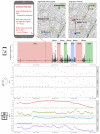Multi-modal data collection for measuring health, behavior, and living environment of large-scale participant cohorts
- PMID: 34155505
- PMCID: PMC8216865
- DOI: 10.1093/gigascience/giab044
Multi-modal data collection for measuring health, behavior, and living environment of large-scale participant cohorts
Abstract
Background: As mobile technologies become ever more sensor-rich, portable, and ubiquitous, data captured by smart devices are lending rich insights into users' daily lives with unprecedented comprehensiveness and ecological validity. A number of human-subject studies have been conducted to examine the use of mobile sensing to uncover individual behavioral patterns and health outcomes, yet minimal attention has been placed on measuring living environments together with other human-centered sensing data. Moreover, the participant sample size in most existing studies falls well below a few hundred, leaving questions open about the reliability of findings on the relations between mobile sensing signals and human outcomes.
Results: To address these limitations, we developed a home environment sensor kit for continuous indoor air quality tracking and deployed it in conjunction with smartphones, Fitbits, and ecological momentary assessments in a cohort study of up to 1,584 college student participants per data type for 3 weeks. We propose a conceptual framework that systematically organizes human-centric data modalities by their temporal coverage and spatial freedom. Then we report our study procedure, technologies and methods deployed, and descriptive statistics of the collected data that reflect the participants' mood, sleep, behavior, and living environment.
Conclusions: We were able to collect from a large participant cohort satisfactorily complete multi-modal sensing and survey data in terms of both data continuity and participant adherence. Our novel data and conceptual development provide important guidance for data collection and hypothesis generation in future human-centered sensing studies.
Keywords: BEVO Beacon; Fitbit; college students; ecological momentary assessment; health; human-centered computing; multi-modal sensing; smartphone.
© The Author(s) 2021. Published by Oxford University Press GigaScience.
Figures




References
-
- Aharony N, Pan W, Ip C, et al. . Social fMRI: Investigating and shaping social mechanisms in the real world. Pervasive Mob Comput. 2011;7(6):643–59.
-
- Wang R, Chen F, Chen Z, et al. . StudentLife: Assessing mental health, academic performance and behavioral trends of college students using smartphones. In: Proceedings of the 2014 ACM International Joint Conference on Pervasive and Ubiquitous Computing. ACM; 2014:3–14.
-
- Purta R, Mattingly S, Song L, et al. . Experiences measuring sleep and physical activity patterns across a large college cohort with fitbits. In: Proceedings of the 2016 ACM International Symposium on Wearable Computers; 2016:28–35.
Publication types
MeSH terms
LinkOut - more resources
Full Text Sources
Research Materials

